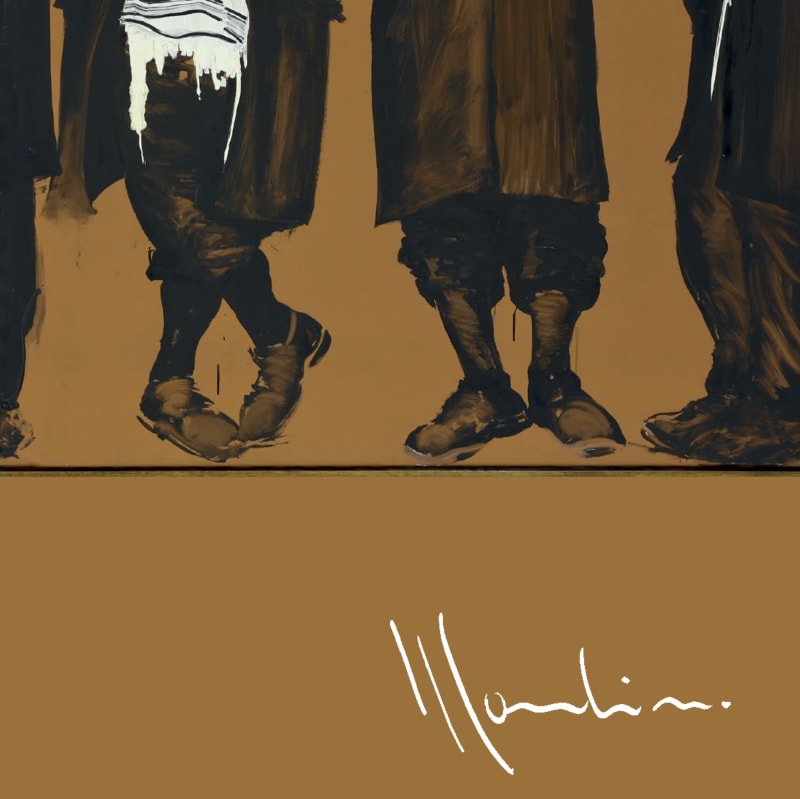M&L Fine art is presents, in association with Giovanni Martino, an exhibition of late works by Aldo Mondino (1938 – 2005), showcasing his seminal paintings on linoleum. This is Aldo Mondino’s third solo exhibition in the United Kingdom, following David Gill Gallery and Leighton House, both in 1992. It is accompanied by a fully illustrated catalogue with a critical essay and a memoir by Gian Enzo Sperone.
Born in Torino, Aldo Mondino began his artistic career in the late 1950s, moving to Paris in defiance of his industrialist father’s wishes. Working first in Stanley William Hayter’s studio and later studying at the École des Beaux-Arts, where he took a course in mosaics with Gino Severini and Riccardo Licata, Mondino immersed himself in the Parisian scene, forging influential relationships with Roberto Matta, Wifredo Lam and Méret Oppenheim. His acquaintance with Arturo Schwarz, the dealer who ‘rediscovered’ Picabia and Duchamp in those same years, sanctioned Mondino’s exposure to a second wave of Surrealist themes and techniques, so pervasive as to make him view Rauschenberg’s 1955 combine of a bed as a surrealist object in and of itself.
Mondino’s return to Torino and subsequent investigations are thus marked by the double pull of, on the one hand, a rich and idiosyncratic painterly repertoire, originating in his Parisian years, and, on the other, a conceptual thrust linked to his proximity with Arte Povera and its main exponents, especially Michelangelo Pistoletto and Giulio Paolini. However, Mondino’s experimental use of organic materials, his deeply ironic sense of humour and highly cultivated persona set him aside from the purely intellectual explorations of his Italian counterparts, except for maybe Piero Manzoni, and closer to international practitioners like Marcel Broodthaers, Joseph Beuys or James Lee Byars.
This exhibition at M&L Fine Art focuses on Mondino’s last major body of work, begun in the mid1980s. Possessing extraordinary narrative eloquence and sustained formal exactitude, the linoleum paintings – occasionally punctuated by three-dimensional additions – at once synthesize and expand the predominant themes in Mondino’s oeuvre: irony (what better play on words than linen and oil), the tyranny of Western cultural icons and their mythologizing functions, and finally the ‘Orient,’ with its cultural and deeply personal connotations.
These are fuelled by Mondino’s relentless traveling, which, starting in the 1980s, brings him into contact first with Morocco and the rest of North Africa, and later Turkey, Spain, Israel and Palestine. Simultaneously, Jewish culture and its symbols become a recurring concern as Mondino rediscovers his religious identity. Portraits of Gnawa dancers, sultans, and, crucially, rabbis and dervishes, all enter Mondino’s practice through the habit of travel paradoxically understood both as a product of and antidote to the frenzy of globalization.
Reducing Mondino’s voyages to mere cultural nomadism would be a mistake, however, for it negates the subversive dimension of his paintings; ambiguously revealing of the problematic connotations of tourism and mass travel. Furthermore, a similarly critical outlook takes hold in Mondino’s approach to his native context, essentially disrupting the stability of predominantly Western-centric art-historical narratives. In two portraits titled Apelle and Protogene, the artist paints Rembrandt as the former and himself as the latter. For an artist so thoroughly invested in the idiosyncrasy of contemporary cultural identification, this resolute artistic gesture is a strong reminder of the need to constantly re-negotiate contemporary art’s relation to its collective historical lineage.
This exhibition, enriched by further works, will travel to Milan in the period 3 April – 17 May 2019, split between Matteo Lampertico Gallery and Galleria Gracis.


